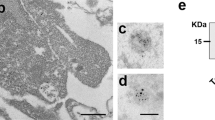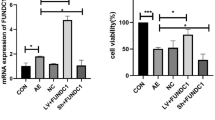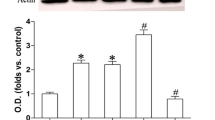Abstract—
Exosome secretion has been demonstrated in the model of induced neuronal resistance to the toxic effect of glutamate (deprivation of trophic factors). Exosomes secretion occurring in the course of development of resistance during deprivation and at the first 24 h after preconditioning, as was shown by dot blot of extracellular fluid using anti-CD63 antibody. The autophagy inhibitor bafilomycin (0.01 µM) significantly reduced the quantity of the secreted exosomes at the stage of autophagy induction and during the first 24 h after induction. At the same time, inhibition of autophagy during trophic factor deprivation prevented the development of resistance, while inhibition of autophagy during the first 24 h after deprivation did not affect the development of resistance. We suggest that the long-term effects of preconditioning may be mediated by exosome secretion.


Similar content being viewed by others
REFERENCES
Hess, D.C., Blauenfeldt, R.A., Andersen, G., Hougaard, K.D., Hoda, M.N., Ding, Y.C., and Ji, X.M., Nat. Rev. Neurol., 2015, vol. 11, pp. 698−710.
Kharbanda, R.K., Mortensen, U.M., White, P.A., Kristiansen, S.B., Schmidt, M.R., Hoschtitzky, J.A., Vogel, M., Sorensen, K., Redington, A.N., and M-acAllister, R., Circulation, 2002, vol. 106, pp. 2881−2883.
Hoole, S.P., Heck, P.M., Sharples, L., Khan, S.N., Duehmke, R., Densem, C.G., Clarke, S.C., Shapiro, L.M., Schofield, P.M., O’Sullivan, M., and Dutka, D.P., Circulation, 2009, vol. 119, pp. 820−827.
Zarbock, A., Schmidt, C., van Aken, H., Wempe, C., Martens, S., Zahn, P.K., Wolf, B., Goebel, U., Schwer, C.I., Rosenberger, P., Haeberle, H., Gorlich, D., Kellum, J.A., Meersch, M., and Renal, R.I., J. Am. Med. Assoc., 2015, vol. 313, pp. 2133−2141.
Hahn, C.D., Manlhiot, C., Schmidt, M.R., Nielsen, T.T., and Redington, A.N., Stroke, 2011, vol. 42, pp. 2960−2962.
Jensen, H.A., Loukogeorgakis, S., Yannopoulos, F., Rimpilainen, E., Petzold, A., Tuominen, H., Lepola, P., MacAllister, R.J., Deanfield, J.E., Makela, T., Alestalo, K., Kiviluoma, K., Anttila, V., Tsang, V., and Juvonen, T., Circulation, 2011, vol. 123, pp. 714−721.
Shimizu, M., Tropak, M., Diaz, R.J., Suto, F., Surendra, H., Kuzmin, E., Li, J., Gross, G., Wilson, G.J., Callahan, J., and Redington, A.N., Clin. Sci., 2009, vol. 117, pp. 191−200.
Konstantinov, I.E., Li, J., Cheung, M.M., Shimizu, M., Stokoe, J., Kharbanda, R.K., and Redington, A.N., Transplantation, 2005, vol. 79, pp. 1691−1695.
Zhou, D., Ding, J.Y., Ya, J.Y., Pan, L.Q., Wang, Y., Ji, X.M., and Meng, R., Aging-Us, 2018, vol. 10, pp. 1825−1855.
van Niel, G., D’Angelo, G., and Raposo, G., Nat. Rev. Mol. Cell Biol., 2018, vol. 19, pp. 213−228.
Stenqvist, A.C., Nagaeva, O., Baranov, V., and Mincheva-Nilsson, L., J. Immunol., 2013, vol. 191, pp. 5515−5523.
Yakovlev, A.A., Lyzhin, A.A., Aleksandrova, O.P., Khaspekov, L.G., and Gulyaeva, N.V., Biomed. Khim., 2016, vol. 62, pp. 656−663.
Yakovlev, A.A., Lyzhin, A.A., Aleksandrova, O.P., Khaspekov, L.G., and Gulyaeva, N.V., Asimmetriya, 2018, vol. 12, pp. 552−557.
Xu, J., Camfield, R., and Gorski, S.M., J. Cell Sci., 2018, vol. 131, pp. 1−11.
Xu, L.L., Cao, H., Xie, Y., Zhang, Y., Du, M.Y., Xu, X.H., Ye, R.D., and Liu, X.F., Brain Res., 2019, vol. 1717, pp. 66−73.
Li, Y., Ren, C.H., Li, H.Y., Jiang, F., Wang, L., Xia, C.Q., and Ji, X.M., Neuroreport, 2019, vol. 30, pp. 834−841.
Funding
The work was carried out the framework of the State Assignments “Multidisciplinary study of the molecular and genetic mechanisms of neuronal plasticity and neurodegeneration” (no. 0129-2014-0002, Institute of Higher Nervous Activity, RAS) and Research Center of Neurology no. 116 012 610 014 “Investigation of cellular and molecular mechanisms of the pathogenesis of neurodegenerative forms of cerebral pathology during their experimental modeling using modern cellular technologies.”
Author information
Authors and Affiliations
Corresponding author
Ethics declarations
This study was conducted in accordance with common rules and norms for the humane treatment of experimental animals.
The authors declare that they have no conflict of interest.
Additional information
Translated by A. Medvedev
Rights and permissions
About this article
Cite this article
Yakovlev, A.A., Lyzhin, A.A., Aleksandrova, O.P. et al. Exosomes Secretion and Autophagy in Long-Term Protection of Neurons from Excitotoxic Damage. Biochem. Moscow Suppl. Ser. B 14, 1–5 (2020). https://doi.org/10.1134/S1990750820010151
Received:
Revised:
Accepted:
Published:
Issue Date:
DOI: https://doi.org/10.1134/S1990750820010151




